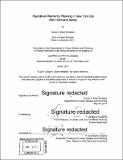Buyouts as resiliency planning in New York City after Hurricane Sandy
Author(s)
Boet-Whitaker, Sonja K. (Sonja Kathleen)
DownloadFull printable version (9.626Mb)
Other Contributors
Massachusetts Institute of Technology. Department of Urban Studies and Planning.
Advisor
Lawrence Susskind.
Terms of use
Metadata
Show full item recordAbstract
Land buyout programs may be used to significantly improve climate resilience by creating a protective ecological buffer area to protect land at high risk of flooding. This thesis assesses the success of the New York State land buyout on the East Shore of Staten Island in achieving this resilient outcome. The New York State buyout program was created after Hurricane Sandy in October 2012 in response to pressure from landowners who had been flooded in the storm. New York City declined to participate in a buyout in response to Sandy but offered to acquire storm-damaged homes in other areas where the New York State buyout was not offered. Through the New York City program, acquired properties would be resold to private entities at auction. In contrast, the New York State program, which purchased 37 acres of land within the 100-year floodplain, was legally bound to hold the properties bought through their program as open space in perpetuity. The state was able to promise former residents that their land would become a buffer for inland areas, increasing resilience along this vulnerable coastline. I analyze the success of the state program in achieving this goal by assessing participation and attrition rates within designated buyout areas, as well as reasons for attrition. I find that the lack of coordinated goals and agreed-upon tools prevented New York Rising from successfully achieving the highest measure of resilience: creating a coastal buffer area to protect residents from sea level rise and future flooding.
Description
Thesis: M.C.P., Massachusetts Institute of Technology, Department of Urban Studies and Planning, 2017. Cataloged from PDF version of thesis. Includes bibliographical references (pages 68-74).
Date issued
2017Department
Massachusetts Institute of Technology. Department of Urban Studies and PlanningPublisher
Massachusetts Institute of Technology
Keywords
Urban Studies and Planning.